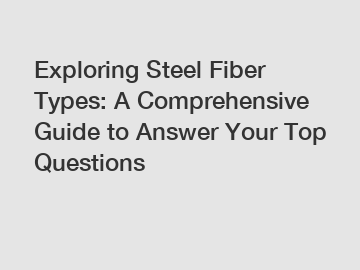Exploring Steel Fiber Types: A Comprehensive Guide to Answer Your Top Questions
well supply professional and honest service.
Steel fiber is a material that has become increasingly popular in various construction projects, thanks to its numerous benefits and advantages. If you are considering using steel fiber in your next project, you may have some questions about the different types of steel fibers available in the market. In this comprehensive guide, we will explore the various types of steel fibers and answer some of the top questions you may have.
1. What are Steel Fibers?

Steel fibers are small, elongated pieces of steel that are added to concrete to improve its strength, ductility, and durability. They act as reinforcement in the concrete matrix, providing additional support and preventing cracking and other forms of damage. Steel fibers can be added to both reinforced and non-reinforced concrete to enhance its properties and performance.
2. Different Types of Steel Fibers.
There are several types of steel fibers available in the market, each with its own unique properties and characteristics. Some of the most commonly used types of steel fibers include:
- Hooked-end Steel Fibers: These fibers have a hooked end that provides better bonding with the concrete matrix, improving their pull-out strength and resistance to cracking.
- Straight Steel Fibers: Straight fibers are typically used in non-reinforced concrete to enhance its toughness and impact resistance.
- Deformed Steel Fibers: Deformed fibers have a rough surface that increases their bonding with the concrete matrix, improving their tensile strength and ductility.
3. Benefits of Using Steel Fibers.
There are several benefits to using steel fibers in concrete construction projects, including:
- Increased Flexural Strength: Steel fibers improve the flexural strength of concrete, making it more resistant to bending and cracking.
- Enhanced Durability: Steel fibers enhance the durability of concrete by reducing shrinkage, cracking, and other forms of damage.
- Improved Toughness: Steel fibers increase the toughness of concrete, making it more resistant to impact and abrasion.
- Cost-effective: Using steel fibers can reduce the need for traditional reinforcement materials, saving time and money in construction projects.
4. Factors to Consider When Choosing Steel Fibers.
When choosing steel fibers for your project, there are several factors to consider to ensure you select the right type for your specific needs. Some of the key factors to consider include:
- Type of Concrete: The type of concrete you are using will determine the type of steel fibers you need. For example, if you are using non-reinforced concrete, you may opt for straight steel fibers.
- Project Requirements: Consider the specific requirements of your project, such as strength, durability, and performance, to select the appropriate steel fibers.
- Fiber Length and Diameter: The length and diameter of the steel fibers will impact their effectiveness and performance in the concrete matrix. Consider these factors when choosing steel fibers for your project.
5. Conclusion.
In conclusion, steel fibers are a versatile and effective material that can enhance the strength, durability, and performance of concrete in construction projects. By understanding the different types of steel fibers available and considering key factors when choosing them, you can ensure your project's success and achieve optimal results. Whether you are looking to increase the flexural strength of your concrete or improve its toughness and durability, steel fibers are an excellent choice for enhancing the properties of your construction material.
Click here to get more.
If you want to learn more, please visit our website melt extract steel fiber.



